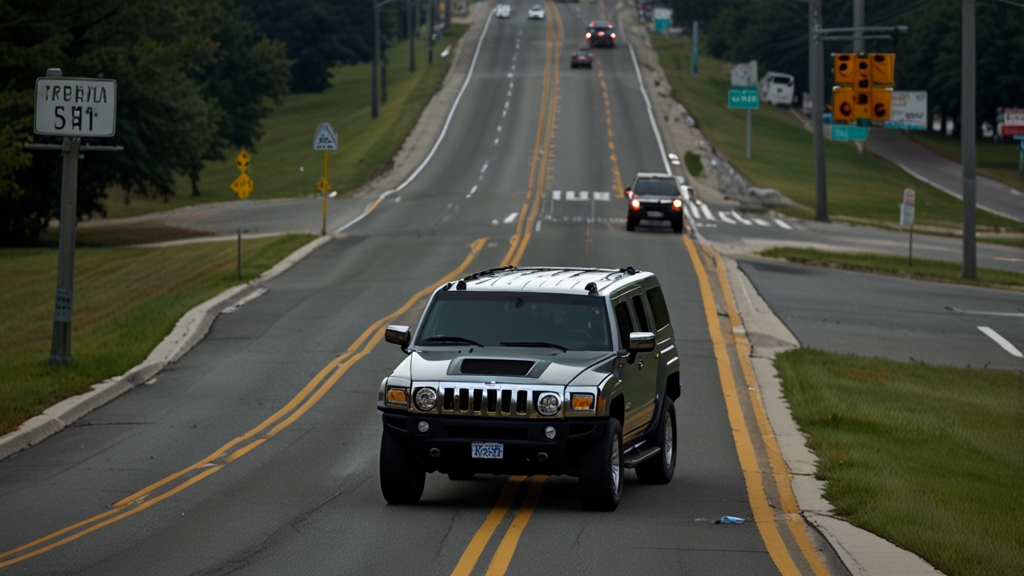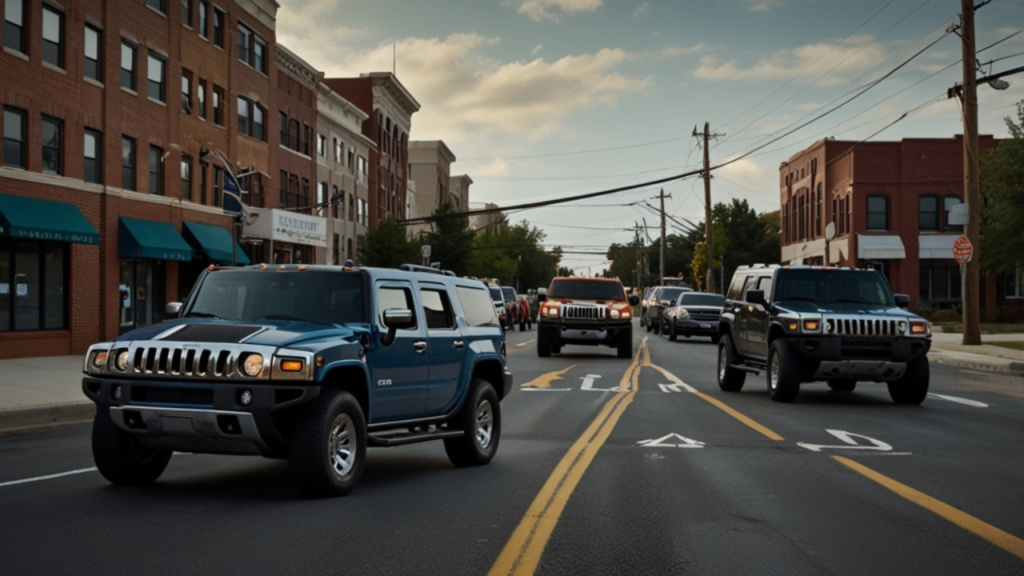Introduction
In the realm of urban planning and traffic management, the Virginia News Continuous Flow Intersection (CFI) is a groundbreaking innovation that addresses long-standing issues of congestion and safety at busy intersections. This blog delves into the specifics of the CFI, particularly as it relates to the 2014 Hummer, exploring its design, implementation, and impact on local communities. By examining real-life examples, historical context, technical specifications, and community involvement, we aim to present a well-rounded view of this transformative traffic solution.
Understanding the Continuous Flow Intersection
What is a Continuous Flow Intersection?
A Continuous Flow Intersection (CFI) is designed to improve traffic flow by allowing vehicles to make left turns without waiting at a traffic signal. In a typical intersection, vehicles turning left often wait for a green signal, causing delays and increased congestion. In a CFI, vehicles are directed to a dedicated lane that allows them to cross opposing traffic, enabling them to turn left more efficiently.
The Advantages of CFIs
The advantages of CFIs are substantial:
- Reduced Delays: By minimizing the waiting time for left turns, CFIs help to reduce overall traffic delays at busy intersections.
- Increased Safety: With fewer conflicts between turning vehicles and oncoming traffic, the likelihood of accidents decreases significantly.
- Better Traffic Flow: CFIs facilitate smoother traffic flow, which can lead to reduced vehicle emissions and improved air quality.
- Cost-Effectiveness: Implementing a CFI can be more economical than constructing overpasses or underpasses.
Historical Context
Traffic Congestion in Virginia
Before the introduction of CFIs in Virginia, the state struggled with significant traffic congestion, particularly in urban areas like Richmond and Northern Virginia. Intersections often became bottlenecks, causing delays for commuters and contributing to increased frustration. The state recognized the need for innovative solutions to manage growing traffic demands.
Development of the CFI Concept
The concept of the Continuous Flow Intersection originated in the 1970s and has since evolved through research and experimentation. The first CFI in Virginia was implemented to test its effectiveness in improving traffic flow. Over the years, numerous studies demonstrated its benefits, prompting further adoption throughout the state.
Implementation Timeline
The first CFI in Virginia was opened in 2007, and its success prompted state officials to consider additional locations for implementation. By 2014, several CFIs were operational across Virginia, with various intersections benefiting from this innovative design. The state also began educating the public about the benefits and mechanics of CFIs to ensure smooth transitions to the new system.
The 2014 Hummer: A Case Study in CFI Implementation
Introduction of the 2014 Hummer
In 2014, Virginia introduced a CFI in conjunction with the Hummer, a vehicle known for its robust design and capability. The integration of the Hummer in this context highlighted the importance of vehicle compatibility with new traffic designs. The Hummer’s size and maneuverability were particularly relevant in demonstrating how vehicles could navigate CFIs effectively.
Technical Specifications of the 2014 Hummer
The 2014 Hummer was equipped with various features that made it suitable for navigating a CFI, including:
- Height and Width: Its robust frame allowed it to navigate wider lanes and handle sharp turns effectively.
- Advanced Safety Features: Equipped with modern safety technologies such as lane departure warnings and collision detection, the Hummer enhanced overall safety at CFIs.
- Fuel Efficiency: Although larger vehicles typically consume more fuel, the 2014 Hummer incorporated improvements aimed at reducing emissions.
Performance in CFIs
The performance of the 2014 Hummer in Continuous Flow Intersections has been noteworthy. The vehicle’s design allows it to make swift left turns while minimizing the need for extended waiting times. This characteristic is crucial in maintaining the efficiency of CFIs and ensuring that larger vehicles do not become bottlenecks in traffic flow.
Real-Life Examples and Case Studies
Virginia’s CFI Success Stories
Several intersections in Virginia have successfully implemented the CFI design, leading to significant improvements in traffic management. One notable example is the intersection of Broad Street and Route 288, where the CFI design has alleviated congestion and improved travel times.
Broad Street and Route 288
This intersection, once known for its congestion, was transformed with the implementation of a CFI. Key improvements include:
- Travel Time Reduction: The CFI design has led to a reported 30% reduction in travel times during peak hours.
- Safety Enhancements: There has been a noticeable decrease in accident rates, attributed to the design’s ability to reduce conflicts between turning and oncoming traffic.
Comparison with Traditional Intersections
Studies have shown that intersections utilizing the CFI design experience a 30-50% reduction in delays compared to traditional signalized intersections. This has resulted in decreased travel times for commuters and an overall improvement in the quality of life for residents in the area.
Community Involvement
Public Feedback and Engagement
The implementation of the CFI in Virginia involved significant community engagement. Public meetings were held to gather input from residents and businesses, allowing them to express their concerns and preferences. This participatory approach ensured that the design met the needs of the community.
Community Workshops
Community workshops were organized to educate residents about the CFI and its benefits. These sessions provided a platform for local stakeholders to ask questions and receive feedback directly from traffic engineers and planners.
Testimonials from Local Residents
Local residents have reported a noticeable improvement in traffic flow and safety since the CFI’s implementation. One resident noted, “The new intersection has made a world of difference. I can now make my left turn without waiting through several cycles of the light.” Another stated, “It feels much safer now that I don’t have to worry about oncoming traffic when I turn left.”
Challenges and Solutions
Implementation Challenges
While the CFI has proven effective, its implementation was not without challenges. Some residents expressed concerns about the initial confusion regarding the new traffic patterns. To address this, the Virginia Department of Transportation (VDOT) launched an educational campaign to familiarize drivers with the new design.
Overcoming Barriers
VDOT worked closely with local law enforcement to monitor the intersection’s operation and ensure compliance with the new traffic rules. Additional signage and pavement markings were introduced to guide drivers and improve overall safety.
Feedback Mechanisms
VDOT established a feedback mechanism, allowing residents to report issues and provide suggestions after the implementation. This system enabled continuous improvement of the CFI design and operation based on real-world experience.
Long-Term Solutions
To ensure the CFI remains effective, VDOT has committed to periodic reviews of traffic patterns and safety data. This proactive approach allows for adjustments and enhancements based on evolving traffic conditions.
Future Trends and Innovations
Smart Traffic Management
Looking ahead, the integration of smart traffic management technologies promises to enhance the effectiveness of CFIs. Adaptive traffic signals that respond to real-time traffic conditions could further improve flow and reduce congestion.
IoT Integration
The Internet of Things (IoT) will play a significant role in the future of traffic management. By equipping vehicles with smart technology, traffic signals can adjust in real-time to accommodate varying traffic volumes, optimizing the flow at CFIs.
Autonomous Vehicle Integration
As the technology for autonomous vehicles evolves, CFIs may be designed to accommodate these vehicles, enhancing safety and efficiency. The potential for vehicle-to-infrastructure communication could revolutionize traffic management, allowing for coordinated movements that minimize congestion.
Pilot Programs
Virginia has initiated pilot programs to explore the integration of autonomous vehicles in CFIs. These programs aim to test the effectiveness of autonomous technology in navigating complex traffic scenarios.
Environmental Impact
Emissions Reduction
The environmental benefits of CFIs extend beyond traffic flow. Studies indicate that the reduction in idling times leads to lower vehicle emissions, contributing to improved air quality. By minimizing delays, CFIs help reduce the carbon footprint of daily commutes.
Urban Heat Island Effect
Implementing CFIs can also address the urban heat island effect. As vehicles spend less time idling, there is a reduced demand for air conditioning in cars, which can contribute to decreased heat emissions. Additionally, the design can encourage the planting of trees and vegetation around intersections, further cooling the urban environment.
Noise Pollution Reduction
Improved traffic flow at CFIs can also lead to decreased noise pollution. With fewer vehicles idling and more efficient movement, the overall sound levels at intersections can be reduced, contributing to a more pleasant urban environment.
Design Considerations for Future CFIs
Infrastructure Requirements
The successful implementation of CFIs requires careful consideration of infrastructure design. Factors such as lane widths, signal placement, and pedestrian access must be thoughtfully planned to ensure safety and functionality.
Adaptability for Different Environments
CFIs should be designed with adaptability in mind, allowing for modifications based on local traffic patterns and conditions. Urban, suburban, and rural settings may require different approaches to the CFI design to maximize effectiveness.
Multimodal Integration
As cities evolve, integrating multiple modes of transportation within the CFI framework becomes increasingly important. This includes accommodating bicycles, public transit, and pedestrian pathways, ensuring a comprehensive approach to traffic management.
Conclusion
The Virginia News Continuous Flow Intersection (CFI) exemplifies innovative solutions to modern traffic challenges. The integration of the 2014 Hummer into this context not only highlights the adaptability of vehicles to new traffic designs but also underscores the importance of community involvement and public feedback. By addressing historical traffic issues, enhancing safety, and providing environmental benefits, the CFI has established itself as a model for future traffic management strategies.
Final Thoughts
As urban areas continue to grow and evolve, the need for innovative traffic solutions like the Continuous Flow Intersection becomes increasingly important. The successful implementation of CFIs in Virginia serves as a powerful example of how urban planners, engineers, and communities can work together to create safer, more efficient transportation systems. By prioritizing public safety, environmental sustainability, and community engagement, CFIs are paving the way for a brighter future in urban traffic management.
Call to Action
If you’re interested in learning more about the benefits of Continuous Flow Intersections or would like to advocate for their implementation in your community, reach out to your local transportation authorities. Engaging in public meetings, providing feedback, and participating in community discussions are essential steps to ensure your voice is heard. Together, we can create a more efficient and safe transportation environment for everyone.
FAQs
1. What is a Continuous Flow Intersection (CFI)?
A Continuous Flow Intersection (CFI) is a traffic design that allows vehicles to make left turns without waiting at a traffic signal. This design minimizes delays and enhances safety by reducing conflicts between turning vehicles and oncoming traffic.
2. How does the CFI improve traffic flow?
The CFI improves traffic flow by allowing left-turning vehicles to merge into dedicated lanes that cross opposing traffic. This design reduces the need for extended waiting times, resulting in smoother traffic movement through the intersection.
3. What are the environmental benefits of CFIs?
CFIs contribute to reduced vehicle emissions by minimizing idling times. Improved traffic flow leads to lower carbon footprints and better air quality in urban areas. Additionally, CFIs can help mitigate the urban heat island effect and decrease noise pollution.
4. How has the 2014 Hummer been affected by CFIs?
The 2014 Hummer, with its robust design and advanced safety features, has demonstrated effective navigation through CFIs. Its size and maneuverability highlight the importance of vehicle compatibility with new traffic designs, ensuring larger vehicles can also benefit from reduced delays and improved safety.
5. Are there plans for future CFIs in Virginia or elsewhere?
Yes, there are ongoing plans to implement more CFIs in Virginia and other states. Traffic engineers are continually researching and developing strategies to enhance urban traffic management, including the integration of smart technologies and multimodal transportation options in future CFI designs.







